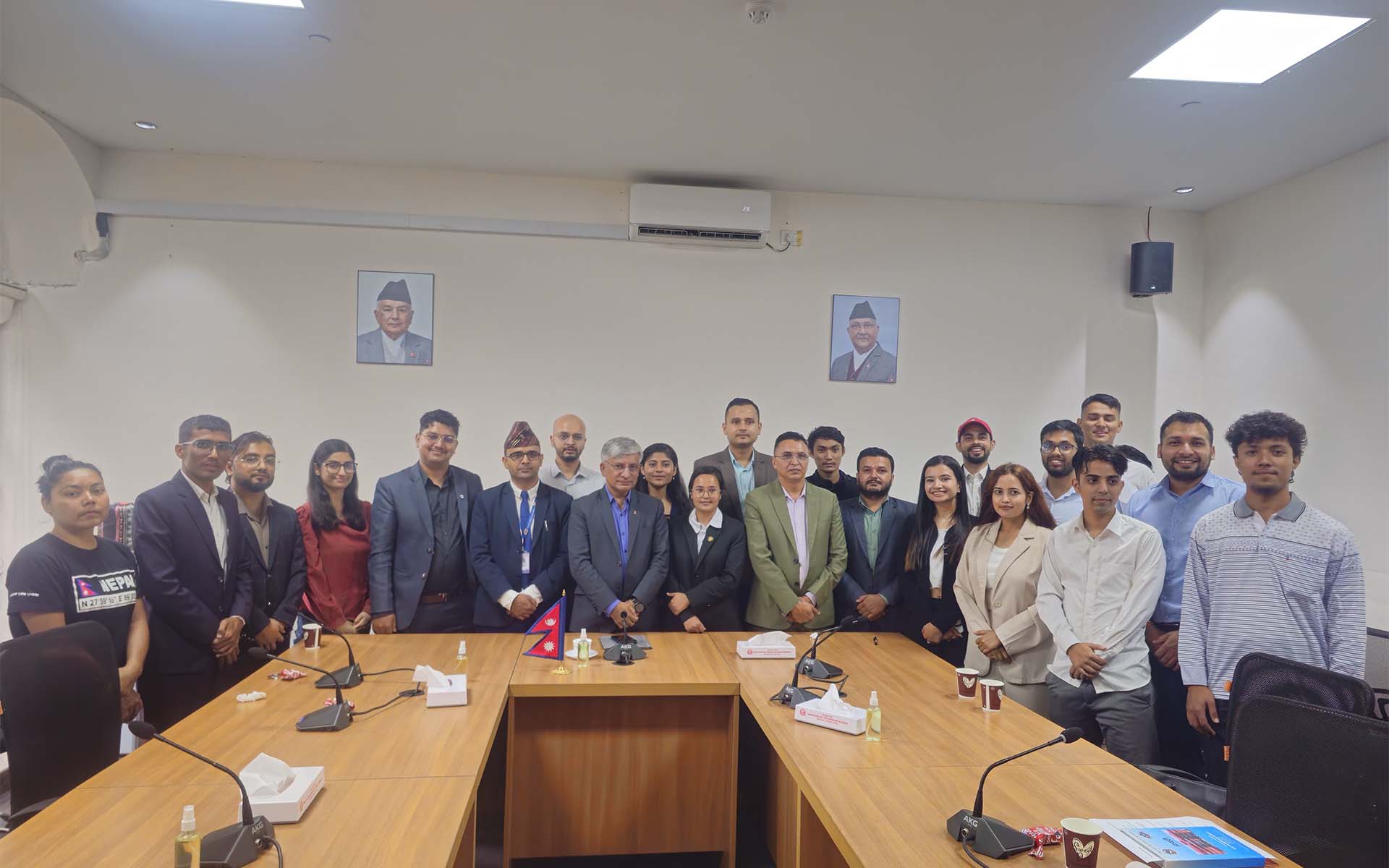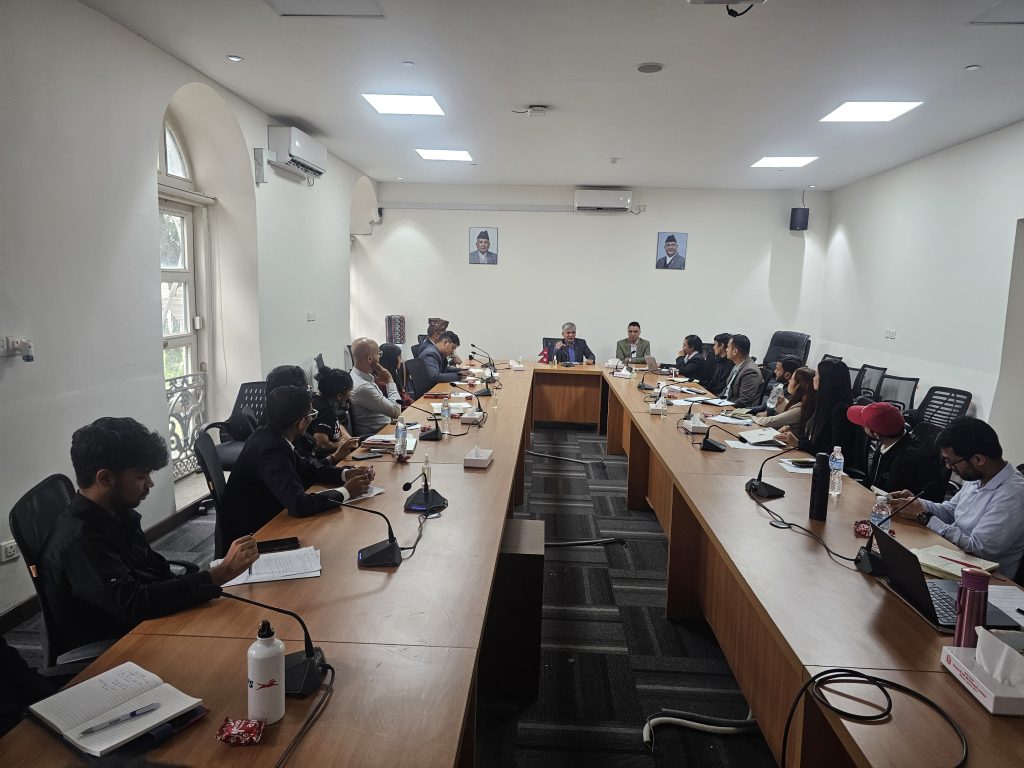
On the day before International Youth Day, seventeen young professionals gathered in Machhapuchhre Hall at Singha Durbar to meet with Chief Advisor to the Prime Minister Bishnu Rimal. Selected from 119 applicants, these participants represented Nepal’s emerging voices in diplomacy, foreign policy, and international relations. What followed was neither ceremonial nor confrontational, but a structured dialogue that demonstrated how serious policy conversations can bridge generational divides.
The Youth Policy Dialogue Series, coordinated by the Institute for Rural Development, has consistently prioritized substance over symbolism. In this fifth episode, each participant had three minutes to present their perspective, balancing critique with solutions. This format kept discussions practical and grounded in Nepal’s diplomatic realities.
The contributions revealed both breadth and depth of youth engagement in Nepal’s international affairs. Kabi Paudel, a policy researcher, emphasized the need for more inclusive platforms that bring together diverse voices in foreign policy discussions. His focus on structural reform resonated with several participants who identified institutional gaps as the primary barrier to meaningful youth involvement.
Ishika Panta brought attention to a critical but often overlooked dimension: the systemic barriers that discourage young women from pursuing careers in diplomacy. Her observation about gendered exclusion in foreign policy spaces sparked broader reflection on representation and access. In her post-event feedback, Panta noted that while the dialogue was meaningful, “a short pre-event briefing document on the PMO’s current priorities in diplomacy and IR could make youth contributions even more targeted and solution-oriented.”
Suman Gyawali from Project Kura media touched on two pressing global realities. He noted the unsettling frequency of international conflicts, remarking that the phrase “that war” has become ambiguous due to the sheer number of ongoing wars worldwide. More significantly, he highlighted the transformative potential of artificial intelligence, noting that Microsoft’s investment in AI surpasses Nepal’s entire GDP. This stark comparison reminded everyone present of the scale of global technological shifts that Nepal must strategically prepare for.
Ideas emerged that were both ambitious and implementable: establishing a Youth Advisory Council to feed ground-level insight into foreign policy; creating structured internship programs linking universities with the Ministry of Foreign Affairs; organizing research-based national conferences that bridge academic insights with policy implementation; and updating diplomatic training to better equip young professionals for 21st-century statecraft. None were floated as abstract ideals. Each came with specific examples, contexts, and a willingness to refine them through dialogue with those in power.
One participant suggested quarterly meetings between youth practitioners and government officials, while another proposed “policy labs where youth work in small groups to co-develop actionable recommendations on specific diplomacy challenges, such as climate diplomacy, regional trade, or technology in foreign policy.” These recommendations reflected a generation that sees collaboration, not competition, as the pathway to influence.

Rimal’s thirty-minute response demonstrated engaged leadership willing to treat youth input as genuine consultation rather than ceremonial listening. He acknowledged the clarity and thoughtfulness of contributions, reiterating that youth voices bring not only energy but the capacity to engage with nuance. His remarks wove together key moments from Nepal’s diplomatic history, providing context and clarity on various topics. For instance, he addressed one participant’s question by explaining the critical difference between non-alignment and neutrality, a distinction that carries significant weight in Nepal’s foreign policy positioning. His willingness to engage substantively with youth perspectives while connecting them to broader strategic considerations modeled the kind of intergenerational dialogue that effective policymaking requires.
The event extended beyond its hour-and-a-half formal structure into networking in Singha Durbar’s garden area. Here, participants continued conversations and explored potential collaborations. Rajib Neupane captured this spirit in his LinkedIn reflection: “The shared insights and dialogues weren’t just about pointing out what’s missing; they were about building what’s possible.”
Post-event feedback revealed both impact and areas for growth. While experience ratings ranged from 3-5 out of 5, the qualitative responses showed deeper engagement. One participant noted: “It was such an interactive session; I liked how the chief advisor was open to hearing voices of the youth and addressed them to some extent.” Another appreciated how the platform was “an inspiring and respectful space for youth-government engagement.”
The feedback also revealed areas for improvement. Participants suggested more focused discussions on Nepal’s Foreign Policy document, better pre-event briefings on government priorities, and follow-up mechanisms to track how youth ideas influence policy processes. These suggestions point to a generation that sees engagement not as a one-off conversation but as an ongoing process of collaborative governance. They want to move beyond consultation toward co-creation, beyond hearing toward influencing, beyond participation toward partnership.
As the event’s coordinator and moderator, I witnessed something significant unfold. The core achievement lies in bringing together youth actively working in diplomacy and international relations with top-level policymakers in the same room. This is happening for the first time in the Prime Minister’s Office, and we remain grateful to the PMO team for providing both space and genuine willingness to engage.
When conversation gaps exist between generations and between practitioners and policymakers, confusion follows. What I observed was young professionals who navigate Nepal’s global positioning daily finally sharing ground-level perspectives directly with those shaping policy from Singh Durbar. The energy was palpable—not frustrated, but focused on possibility.

This dialogue series refuses to conflate access with impact. It treats access as a starting point and impact as a shared responsibility. What distinguished this gathering was its demonstration that meaningful youth-government engagement is both possible and productive. By bringing carefully chosen young professionals face-to-face with senior leadership willing to listen and respond, it modeled engagement that is neither symbolic nor adversarial, but collaborative in the truest sense.
The significance lies in demonstrating that substantive youth engagement is both possible and productive. If the atmosphere in Machhapuchhre Hall indicates anything, it’s that Nepal’s foreign policy conversations are evolving to include fresh voices without losing institutional experience. The foundation exists. Whether it can support heavier policy loads in the coming months and years remains to be seen.
Trust that competence isn’t defined by age. Trust that intergenerational dialogue, approached in good faith, can yield more than the sum of its parts. Trust that once such bridges are built, they can carry the weight of genuine policy transformation.